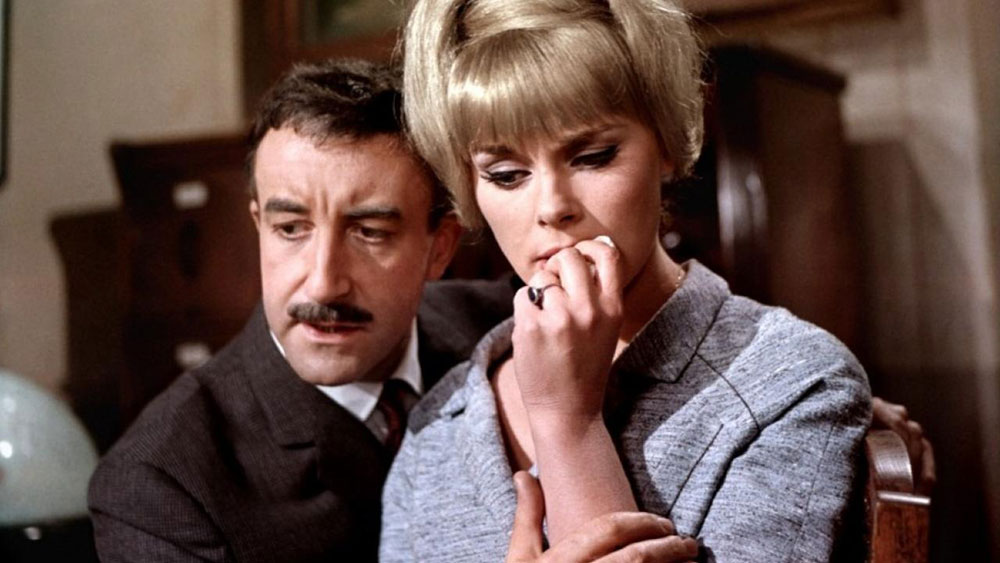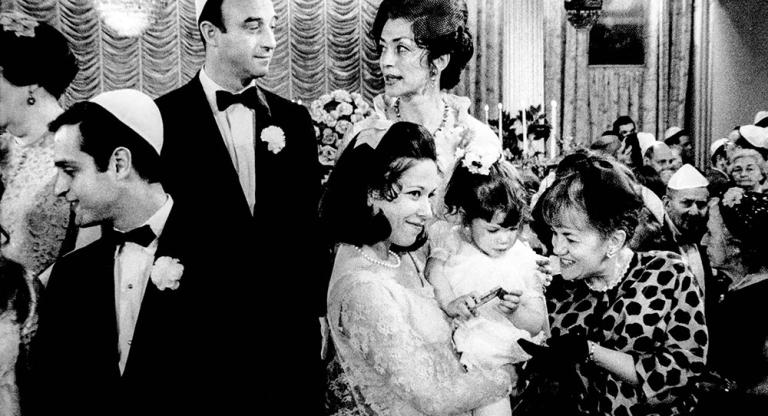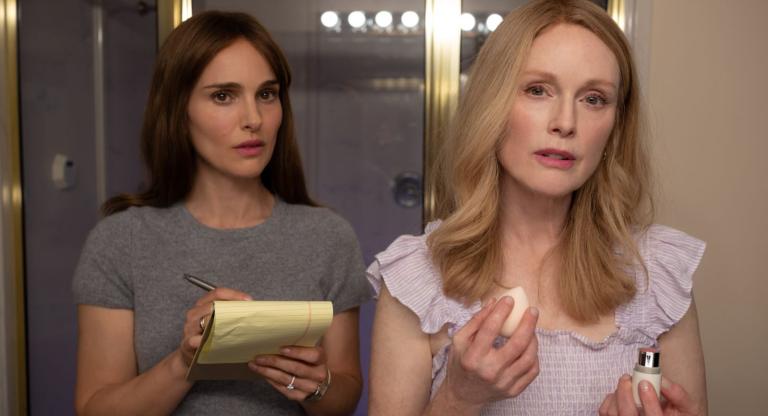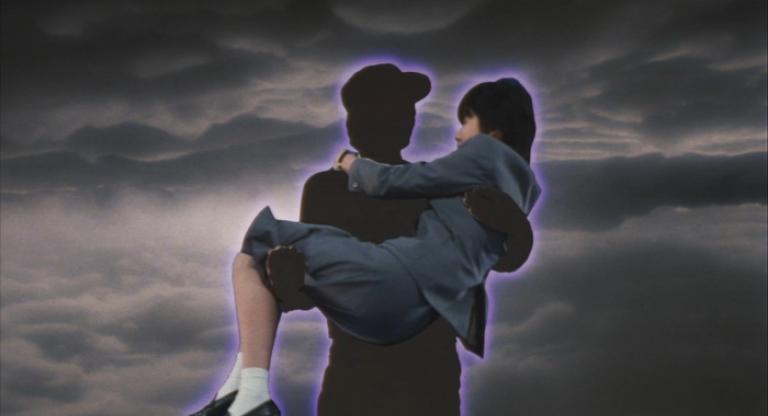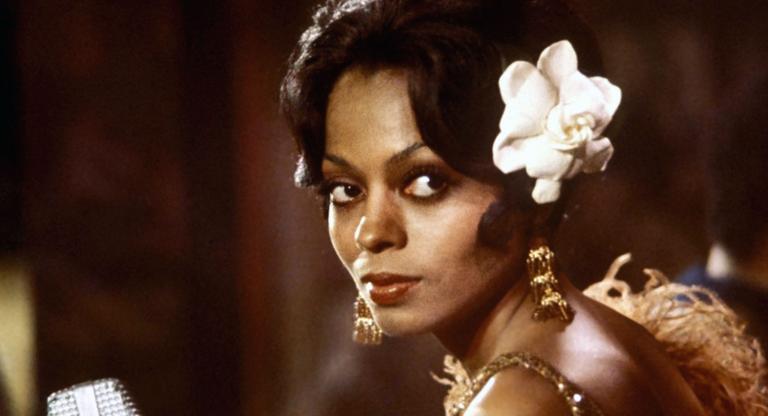The sophisticated, the vulgar; the sweet, the sour: always they wrestle within Blake Edwards. Contaminations abound in his work: mostly comedies, with select lapses into the musical (the glorious Darling Lili, 1970) or outright melancholy (Days of Wine and Roses, 1962; Wild Rovers, 1971). But we should not measure his mixed-mode visions to those of, say, Chaplin, who goes down smoother. (This does not make Edwards inferior to Chaplin.) Let’s never play the tiresome Harold Bloomian game of Who’s Best at Cinema Forever and Ever. The more warts and pockmarks, the more honest and beautiful Edwards’s worlds are. And the more we slide into Edwards, the more refreshed our souls. Yes, Blake: Inject your gags with pain! Deflate your tragedies with zip and zany!
Case in point: the perfect, dialogue-free opening of A Shot in the Dark (1964). What have we here? A château. A man (it's George Sanders, but that doesn't matter—he's still just A Man in this scene). He sneaks out of his greenhouse into the main house. He bears champagne, glasses, a tray: he's going to rendezvous with a lady. But he suspects he's being watched. And lo and behold, he is: by another man. And then yet another man comes, and then another woman. Like rats, they scamper about a house and its gardens, which we never enter or explore. Yet there is a profound musical pleasure in seeing these seesawing bodies go up balconies, down staircases, enter with flowers, exit with guns. The first four minutes is silent sneaking about this way and that to avoid being "caught," set to a singer (à la Connie Francis) belting a lovely, bathetic Henry Mancini tune, "Shadows of Paris," that reeks of the Gallic. No one is doing anything illegal—yet—only indulging in the age-old pleasures of the flesh. It’s the network of desire in one elegant tableau.
Who is sleeping with whom? As we observe these busy, sneaky little nothings and their busy, sneaky little scrambles at night—first one room, no that’s the wrong room, now another room, now a third room, a bed, a light, a kiss, a flowerpot, and a gun—making love is shown to be nothing but games of deceit. Such is Edwards’s none-too-rosy view of a moribund institution. But none of these machinations would be intriguing in and of itself. People fuck behind other people’s backs—whatever. Here, then, creeps in the Blake Edwards touch: his graceful distance, the grace of distance. The world, to him, looks more interesting framed in Panavision, for the extreme width keeps people apart and puts them at war for our attention with objects that, given the chance, can come alive and kill.
The world, moreover, is set on a flat, nearly two-dimensional plane—the dollhouse effect of Jerry Lewis's The Ladies Man (1961)—so that, from the beginning, the characters’ shenanigans seem a bit unreal. The flatness recalls Lubitsch, what with his hanging outside apartments and obsession with open and closed doors. But in Edwards, the action is shot with a delicate sordidness: the adulterers move about like automatrons, like Jiri Trnka's puppets. But of course, those puppets had souls. These men and women may not even be flesh and blood. Someone, a chauffeur I believe, is killed. The beautiful maid (Elke Sommer) is under suspicion. But we don't care about these people. Again, they're sneaky, rich little nothings; we care about them only to the extent that we care about how they negotiate space. Enter Inspector Clouseau (Peter Sellers), who not only brutally and hilariously dominates space, turning straight lines into crooks and curves, but who also solves the murder mystery, drives his boss Dreyfus (Herbert Lom) insane, and outdoes these dolls in their bumbling, maximal stupidity—doing so, moreover, with something they'll never possess: charm.
A Shot in the Dark is not my favorite Pink Panther film: that would be The Pink Panther Strikes Again (1976), where the gags burble with a lo-fi cruelty, are more outlandish; Edwards’s eye for the frame was never crisper or finer. It is not even my favorite Edwards-Sellers collaboration: The Party (1968), Edwards's brilliant, improvisational tribute to Jacques Tati. In Shot, there are no belly-laughs, most of the schtick is contained to consciously dumb bits with Sellers in French drag pronouncing words like "bump" as "beump", and the film pat-pat-patters along without necessarily trying to present big statements about the state of the anguished modern soul through masterful comic setpieces (e.g., Jerry Lewis, Chaplin). Not really Edwards’s thing. He’s more of a comic anarchist. Like Tati, he nibbles, making sure a house is in proper order and beautifully prepared—before he takes a sledgehammer and smashes its insides, especially the grand piano, to little bits.
One final word on my favorite gag in the film. When Chief Inspector Dreyfus cuts the cap off his cigar, he does so with a tiny guillotine. This made me burst into such a guffaw. Edwards gives the guillotine-cutter a rapid close-up before moving on with the scene. No one comments upon it, not even when the gag is repeated later. Light, surreal, verging-on-bad-taste jokes like this are precisely what make me adore his films. To paraphrase the iconic Edwards protagonist Holly Golightly, quel gumption. No one else would dare but Blake.
A Shot in the Dark screens this week at Lark Theater.
